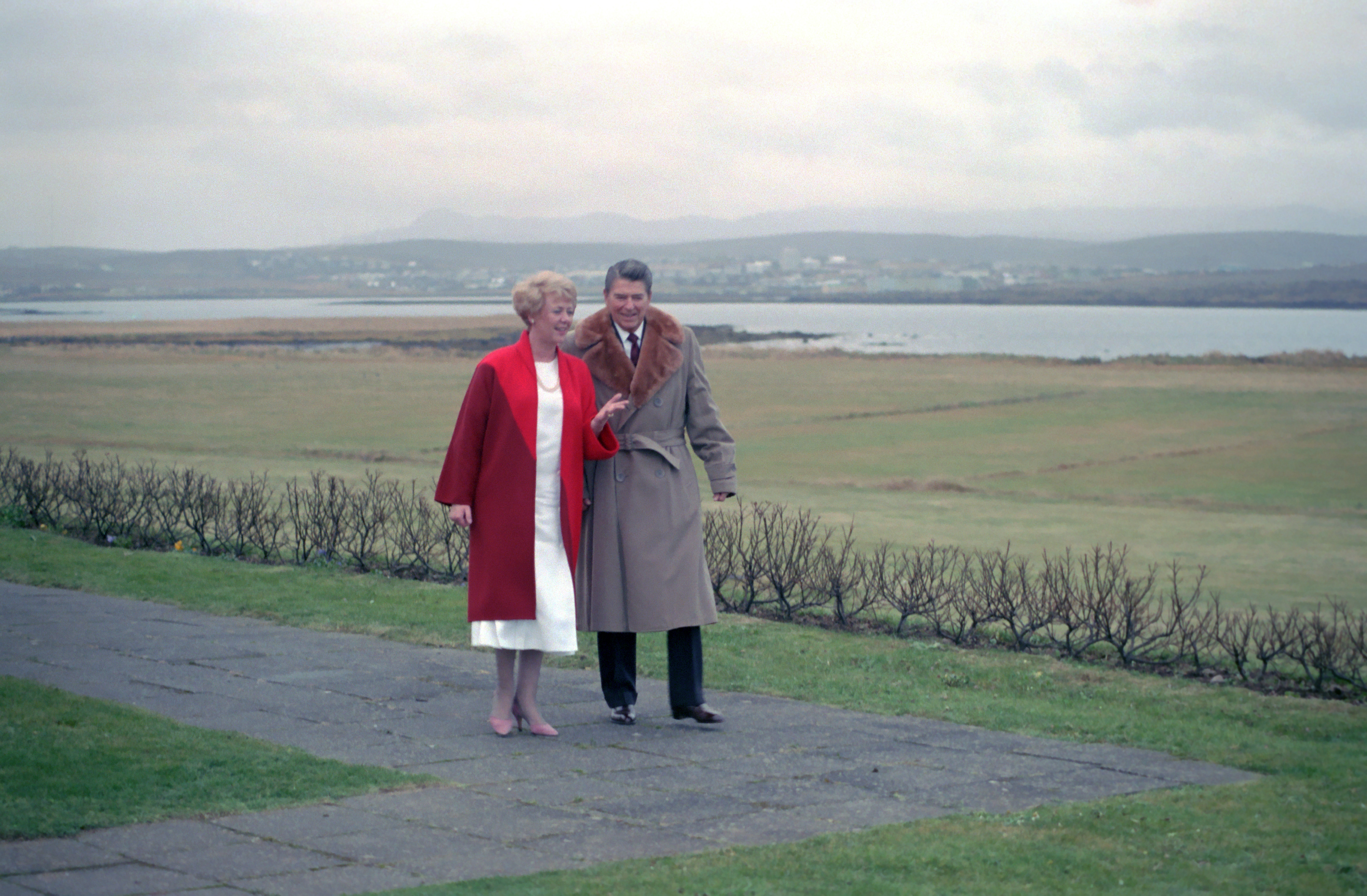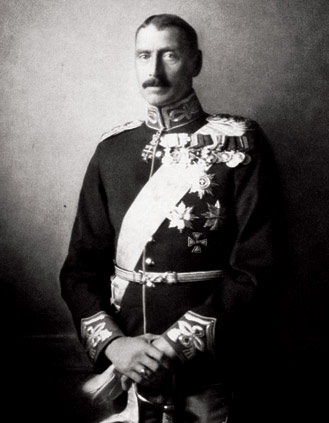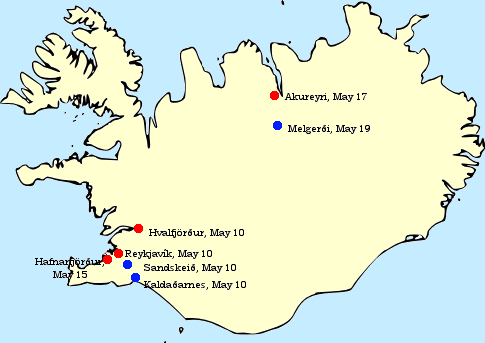|
Medieval Iceland
The recorded history of Iceland began with the settlement by Viking explorers and the people they enslaved from Western Europe, particularly in modern-day Norway and the British Isles, in the late ninth century. Iceland was still uninhabited long after the rest of Western Europe had been settled. Recorded settlement has conventionally been dated back to 874, although archaeological evidence indicates Gaelic monks from Ireland, known as papar from sagas, may have settled Iceland earlier. The land was settled quickly, mainly by Norsemen who may have been fleeing conflict or seeking new land to farm. By 930, the chieftains had established a form of governance, the ''Althing'', making it one of the world's oldest parliaments. Towards the end of the tenth century, Christianity came to Iceland through the influence of the Norwegian king Olaf Tryggvason. During this time, Iceland remained independent, a period known as the Old Commonwealth, and Icelandic historians began to document ... [...More Info...] [...Related Items...] OR: [Wikipedia] [Google] [Baidu] |
Danish–Icelandic Trade Monopoly
The Danish–Icelandic Trade Monopoly (Icelandic: ''Einokunarverslunin'') was the monopoly on trade held by Danish merchants in Iceland in the 17th and 18th centuries. Iceland was during this period a territory controlled by the Danish-Norwegian Crown. The origins of the monopoly may be traced to the mercantilist policies of Denmark-Norway, and its aim was to support Danish merchants and Danish trade against the Hanseatic League of Hamburg, increasing the power of the King of Denmark in Iceland. The monopoly was enacted by a set of laws passed in 1602 and lasted until 1786. During this period, trade was permitted to take place in 20 (later 25) designated trading posts, according to a fixed rate of prices determined by the king. The merchants acquired the rights to the trading posts in exchange for a fixed rent, with the Vestmannaeyjar being rented at a higher price. For the majority of this period, these leases were managed by Danish trading companies, however, from 1759–1763 ... [...More Info...] [...Related Items...] OR: [Wikipedia] [Google] [Baidu] |
2008–2011 Icelandic Financial Crisis
The Icelandic financial crisis was a major financial crisis, economic and political event in Iceland between 2008 and 2010. It involved the default (finance), default of all three of the country's major privately owned commercial banks in late 2008, following problems in refinancing their current liability, short-term debt and a bank run, run on deposits in the Netherlands and the United Kingdom. Relative to the size of its economy, Iceland's systemic banking collapse was the largest of any country in economic history. The crisis led to a severe recession and the 2009 Icelandic financial crisis protests. In the years preceding the crisis, three Icelandic banks, Kaupthing Bank, Kaupthing, Landsbanki and Glitnir (bank), Glitnir, multiplied in size. This expansion was driven by ready access to credit in international financial markets, in particular money markets. As the 2008 financial crisis unfolded, investors perceived the Icelandic banks to be increasingly risky. Trust in the ba ... [...More Info...] [...Related Items...] OR: [Wikipedia] [Google] [Baidu] |
Vigdís Finnbogadóttir
Vigdís Finnbogadóttir (; born 15 April 1930) is an Icelandic politician who served as the fourth president of Iceland from 1980 to 1996, the first woman to hold the position and the first in the world to be democratically elected president of a country. Having served for 16 years, she was also the longest-serving elected female head of state in history. Vigdís is a UNESCO Goodwill Ambassador and a member of the Club of Madrid. Early life and career Vigdís was born on 15 April 1930 in Reykjavík. Her father was a civil engineer, and her mother was a nurse who headed the national nurses association. The following year, her younger brother Þorvaldur was born; he did not survive to adulthood, as he drowned in Hreðavatn. Vigdís enrolled at the University of Grenoble in 1949, later switching to the Sorbonne. She studied English and French literature, giving special emphasis to plays, and she graduated in 1953. Vigdís was married in 1954. The same year, she began acting, co ... [...More Info...] [...Related Items...] OR: [Wikipedia] [Google] [Baidu] |
North Atlantic Treaty Organization
The North Atlantic Treaty Organization (NATO ; , OTAN), also called the North Atlantic Alliance, is an intergovernmental transnational military alliance of 32 member states—30 European and 2 North American. Established in the aftermath of World War II, the organization implements the North Atlantic Treaty, signed in Washington, D.C., on 4 April 1949. NATO is a collective security system: its independent member states agree to defend each other against attacks by third parties. During the Cold War, NATO operated as a check on the threat posed by the Soviet Union. The alliance remained in place after the dissolution of the Soviet Union and the Warsaw Pact, and has been involved in military operations in the Balkans, the Middle East, South Asia, and Africa. The organization's motto is . The organization's strategic concepts include deterrence. NATO's main headquarters are located in Brussels, Belgium, while NATO's military headquarters are near Mons, Belgium. The a ... [...More Info...] [...Related Items...] OR: [Wikipedia] [Google] [Baidu] |
Founding Of The Republic Of Iceland
A constitutional referendum was held in Iceland between 20 and 23 May 1944.Dieter Nohlen & Philip Stöver (2010) ''Elections in Europe: A data handbook'', p961 The 1918 Danish–Icelandic Act of Union declared Iceland to be a sovereign state separate from Denmark, but maintained the two countries in a personal union, with the king of Denmark also being the king of Iceland. In the two-part referendum, voters were asked whether the union with Denmark should be abolished, and whether to adopt a new republican constitution. Both measures were approved, each with more than 98% of valid votes in favour. Including invalid ballots, voter turnout was 98% overall, and 100% in two constituencies: Seyðisfjörður and Vestur-Skaftafjellssýsla. Results Aftermath The union with Denmark was dissolved on 17 June 1944. As Denmark was still occupied by Nazi Germany, many Danes felt offended that the step was taken at that time. Nevertheless, King Christian X of Denmark sent a message of c ... [...More Info...] [...Related Items...] OR: [Wikipedia] [Google] [Baidu] |
German Invasion Of Denmark (1940)
The German invasion of Denmark (), was the German attack on Denmark on 9 April 1940, during the World War II, Second World War. The attack was a prelude to the Norwegian campaign, invasion of Norway (, 9 April – 10 June 1940). Denmark's strategic importance for Germany was limited. The invasion's primary purpose was to use Denmark as a staging ground for operations against Norway, and to secure supply lines to the forces about to be deployed there. An extensive network of Freya radar, radar systems was built in Denmark to detect British bombers bound for Germany. The attack on Denmark was a breach of the non-aggression pact Denmark had signed with Germany less than a year earlier. The initial plan was to push Denmark to accept that German land, naval and air forces could use Danish bases, but Adolf Hitler subsequently demanded that both Norway and Denmark be invaded. Denmark's military forces were inferior in numbers and equipment, and after a short battle were forced to sur ... [...More Info...] [...Related Items...] OR: [Wikipedia] [Google] [Baidu] |
Invasion Of Iceland
The United Kingdom invaded Iceland on 10 May 1940, during World War II using its Royal Navy and Royal Marines forces. The operation, codenamed Operation Fork, occurred because the British government feared that Kingdom of Iceland, Iceland would be used militarily by Nazi Germany, which had German invasion of Denmark (1940), overrun Denmark a month earlier. Although Iceland was independently governed, it was in a personal union with Denmark, which was largely responsible for its foreign relations. The Government of Iceland issued a protest, charging that its neutrality had been "flagrantly violated" and "its independence infringed". At the start of World War II, the UK imposed strict export controls on Icelandic goods, preventing profitable shipments to Germany, as part of its naval blockade. The UK offered assistance to Iceland, seeking co-operation "as a belligerent and an ally", but the Icelandic government refused and reaffirmed its neutrality. The German diplomatic presence ... [...More Info...] [...Related Items...] OR: [Wikipedia] [Google] [Baidu] |
Iceland In World War II
At the beginning of World War II, Kingdom of Iceland, Iceland was a Sovereignty, sovereign Monarchy, kingdom in personal union with Denmark, with King Christian X as head of state. Iceland officially remained neutral throughout World War II. However, the British Invasion of Iceland, invaded Iceland on 10 May 1940. On 7 July 1941, the defence of Iceland was transferred from Britain to the United States, which was still a neutral country until five months later. On 17 June 1944, 1944 Icelandic constitutional referendum, Iceland dissolved its union with Denmark and the Danish monarchy and declared itself a republic, which it remains to this day. Background The British government was alarmed by Germany's growing interest in Iceland over the course of the 1930s. When war began, Denmark and Iceland declared neutrality and limited visits to the island by military vessels and aircraft of the belligerents. Neutrality During the Nazi Germany, German occupation of Denmark, contact betwee ... [...More Info...] [...Related Items...] OR: [Wikipedia] [Google] [Baidu] |
World War II
World War II or the Second World War (1 September 1939 – 2 September 1945) was a World war, global conflict between two coalitions: the Allies of World War II, Allies and the Axis powers. World War II by country, Nearly all of the world's countries participated, with many nations mobilising all resources in pursuit of total war. Tanks in World War II, Tanks and Air warfare of World War II, aircraft played major roles, enabling the strategic bombing of cities and delivery of the Atomic bombings of Hiroshima and Nagasaki, first and only nuclear weapons ever used in war. World War II is the List of wars by death toll, deadliest conflict in history, causing World War II casualties, the death of 70 to 85 million people, more than half of whom were civilians. Millions died in genocides, including the Holocaust, and by massacres, starvation, and disease. After the Allied victory, Allied-occupied Germany, Germany, Allied-occupied Austria, Austria, Occupation of Japan, Japan, a ... [...More Info...] [...Related Items...] OR: [Wikipedia] [Google] [Baidu] |
Rulers Of Denmark
This is a list of Monarchy of Denmark, Danish monarchs, that is, the kings and queen regnants of Denmark. This includes: * The Kingdom of Denmark (up to 1397) ** Personal union of Denmark and Norway (1380–1397) * The Kalmar Union (1397–1536) ** Union of Denmark, Norway and Sweden (1397–1523) ** Union of Denmark and Norway (1523–1536/1537) * The United Kingdoms of Denmark–Norway (1536/1537–1814) * The Kingdom of Denmark (1814–present) ** Iceland (since the union between Denmark and Norway in 1380; independent kingdom in a personal union with Denmark 1918–1944; a sovereign republic since 1944) ** Greenland (since the union between Denmark and Norway in 1380; effective Danish–Norwegian control began in 1721; integrated into the Danish realm in 1953; internal home rule introduced 1979; Self-governance, self-rule assumed in 2009; Greenland has two out of 179 seats in the Danish parliament Folketinget) ** Faroe Islands (since the union between Denmark and Norway in 138 ... [...More Info...] [...Related Items...] OR: [Wikipedia] [Google] [Baidu] |
Kingdom Of Iceland
The Kingdom of Iceland (; ) was a sovereign and independent country under a constitutional and hereditary monarchy that was established by the Act of Union with Denmark signed on 1 December 1918. It lasted until 17 June 1944 when a national referendum established the republic of Iceland in its place. Under a personal union, due to the Act of Union, the monarch was simultaneously monarch of Denmark. The Parliament of Iceland asked that Denmark represent Iceland internationally, and day-to-day matters were delegated to a Danish plenipotentiary for Icelandic affairs based in Reykjavík, and – after the German invasion of Denmark in 1940 – a regent was appointed. History Origins of Danish rule Because of the Kalmar Union, Iceland had been under the control of the Crown of Denmark since 1380, although formally it had been a Norwegian possession until 1814. In 1874, one thousand years after the first acknowledged settlement, Denmark granted Iceland home rule. The const ... [...More Info...] [...Related Items...] OR: [Wikipedia] [Google] [Baidu] |








